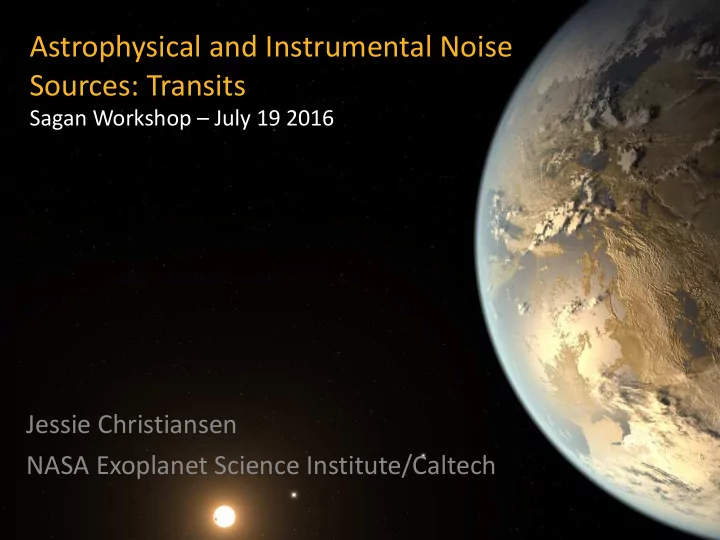

Astrophysical and Instrumental Noise Sources: Transits Sagan Workshop – July 19 2016 Jessie Christiansen NASA Exoplanet Science Institute/Caltech
Why do we care about noise? Take the example of the Kepler mission – the primary goal was determining the occurrence rate of Earth-like planets around sun-like stars That’s hard! Earth creates a 85ppm deep transit Mission design has to account for all the known sources of noise – error budget of 20ppm in 6.5h How big a telescope do we need to build? How faint a star can we look at? What kind of stars can we look at? How expensive a detector do we need to buy? What is the overall noise floor achievable?
Overview Spacecraft do stuff! Stars do stuff! Credit: Dan Foreman-Mackay, Davos
Overview Atmospheres do stuff! Telescopes do stuff! Stars do stuff! atmosphere (Planets do stuff, too!) Detectors do stuff! Credit: Dan Foreman-Mackay, Davos
Stars do stuff… Credit: Xavier Dumusque
Stars do stuff… Credit: NASA/SDO Oscillations (<15 minutes, <1%) Granulation (15min-2days,<0.1%) Magnetic activity - spots (2days to weeks, <10%)) - flares (stochastic,<few%) Davenport et al. 2014 Pulsations (mins to yrs, <10s of %) Paz-Chinchon+2015 Molner+2014 Eclipses (hrs to yrs, <50%) Credit: Arcetri Solar Physics Group/NSO Christiansen, PhD thesis, 2007
Different stars do different stuff… Subgiant, giant stars; Oscillations, pulsations FGK dwarf stars; Oscillations, Granulation, Spots M dwarf stars; Spots , flares Christiansen+2012
Telescopes do stuff… They typically have pointing jitter Intra-pixel variations, e.g. Spitzer, K2 (not Kepler!) • irachpp.spitzer.caltech.edu Christiansen+2010
Telescopes do stuff… They typically have pointing jitter Intra-pixel variations, e.g. Spitzer, K2 (not Kepler!) • Vanderburg+2016
Telescopes do stuff… They typically have pointing jitter Intra-pixel variations, e.g. Spitzer, K2 (not Kepler!) • Inter-pixel variations, e.g. EPOCh • Ballard+2010 Christiansen+2010
Telescopes do stuff… They typically have pointing jitter Intra-pixel variations, e.g. Spitzer, K2 (not Kepler!) • Inter-pixel variations, e.g. EPOCh • They experience thermal variations, e.g. Kepler Christiansen+2013 Smith+2012
The atmosphere does stuff… Essentially it changes transparency as a function of time, via - Airmass (colour-dependent extinction) - Humidity (precipitable water vapour) - Variable sky background, cloud cover And the point-spread-function of the light also changes - Seeing (temperature, airmass, windspeed); similar effects to thermal changes Often on similar timescales to transits L Generally affect all stars, can be treated with common mode models (PCA, SVD, etc) J Berta+2012 Christiansen, PhD thesis, 2007 Christiansen+2013
Detectors do stuff…
Detectors do stuff…
Detectors do stuff… 3 years of data… 372 days! 4 years of data… log(Period(days)) Tenenbaum+2014
Summary There is a lot standing between you and a clean transit signal! You can make clever choices in order to minimise/mitigate/isolate noise sources (or at least the timescales of those noise sources) - Target selection - Stability of instrument - The more the merrier, for treating common mode systematics) For remaining (and sometimes unavoidable) noise sources, exoplaneteers have been relying on increasingly sophisticated noise models (e.g. Gaussian process) – see rest of #sagan2016!
Recommend
More recommend